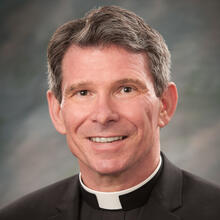A Homily for the Solemnity of the Blessed Virgin Mary, the Mother of God
Readings: Numbers 6:22-27 Galatians 4:4-7 Luke 2:16-21
Even as an old woman, my mother could still recite the New Year’s wish she had been taught as a small child to pronounce in German.
Wir Wünschen euch ein
Glückliches Neues Jahr,
Ein langes Leben,
Gesundheit,
Friede und Einigkeit,
Und nach dem Tod,
Die ewige Glückseligkeit.
We wish you
A happy new year,
A long life,
Health,
Peace and goodwill,
And after death,
Eternal happiness.
It was a wish that greeted you at your door on New Year’s Day. You followed it up by giving the well-wishers a coin and inviting them into your home for refreshments. There are still traces of the practice in the Kansas counties settled by my mother’s people, Volga Germans, who came to America by way of Russia, where they had farmed for a century at the invitation of the German-born Russian czarina, Catherine the Great.
New Year’s Day Wünschung or “wishing” is an example of what anthropologists call “sympathetic magic.” Its practice is nigh universal among indigenous peoples across time. You promote the action of the supernatural by showing it what it is that you want of it. For example, drums are pounded and water is thrown onto soil to promote thunder and rain.
The Christmas season, which began life as Yuletide, is full of sympathetic magic. Long before Christianity, pine boughs were raised high with accompanying torches. In darkest winter, these living greens and fire were intended to call the sun god back to life.
The New Year’s notion was that the coming year would take its lead from whatever characterized the first day of the year. So you wanted the day to be marked by abundance and generosity. The ancient Romans celebrated Saturnalia in December, a time of riotous celebration, again hopefully setting the tone for the year to come.
This was the world in which the Christian faith came to be born. Of course, as her message was the free and unmerited action of God on our behalf, the church could have no truck with magic, with any attempt to manipulate the supernatural.
Contrary to what a first generation of scholarship suggested, the church did not respond to Saturnalia by arbitrarily creating the date of Christ’s birth to compete with it or the Roman feast of the Unconquered Sun (Sol Invictus). Better evidence suggests that the savior’s date of birth was determined by calculating from the date of his death in the solar calendar, March 25.
In the ancient world, great men were thought to lead lives perfectly rounded on the calendar, so they should depart from this world on the same day they entered it. So, if Christ was conceived on the day of his death, the date we celebrate as the Annunciation, he would have been born nine months later, on Dec. 25.
The church did, however, respond to Saturnalia by urging her faithful to open the new year with prayer and fasting instead of debauchery. Early Latin Mass prayers for Jan. 1 invoked protection from idols, and St. Augustine told his congregation:
Let them give new year’s gifts: you should give alms. Let them sing boisterous songs: you should open your hearts to the word of God. Let them rush to the theatre: you should rush to church. Let them get drunk: you should fast (Sermon 198.2).
Just as Christmas was ultimately rooted in the Jewish, not the Roman, calendar, honoring Mary as the Mother of God on the octave of the birth comes from contemplating the depths of Christmas. In complete faithfulness to the covenant, the savior came forth from a Jewish maiden, but he did so in a manner that exceeded human calculations. A virgin gave birth, inaugurating a new era in God’s relationship with us. In her person, Mary is both God’s utter faithfulness and complete freedom.
But there is still a hint of the old ways about this day. Each year enters fresh, free and forceful. Twelve months later, it limps away. If the first day of the year sets the tone for the rest, so Mary is the model, the great hope and solace of the Christian people.
Mary and the child she bore are the first fruits of a new creation. We fall short of them, but they remain our hope, our inspiration. By pondering Mary on the eighth day of Christmas, we remember that we, too, have been called into a new age, a new way of life. We must live differently, and now is the time to begin. Not a bad way to start another new year.








